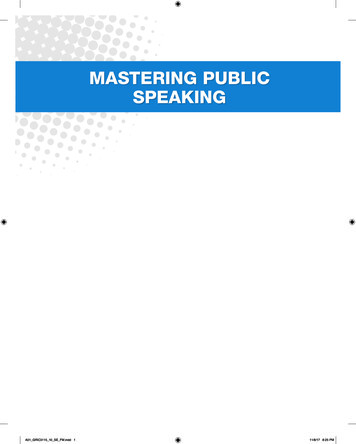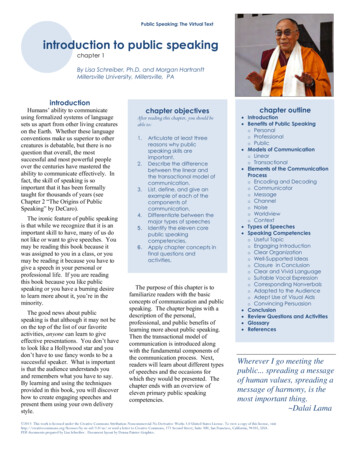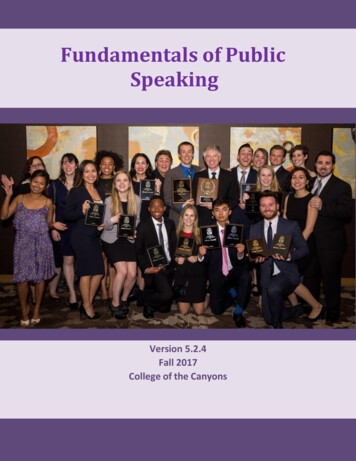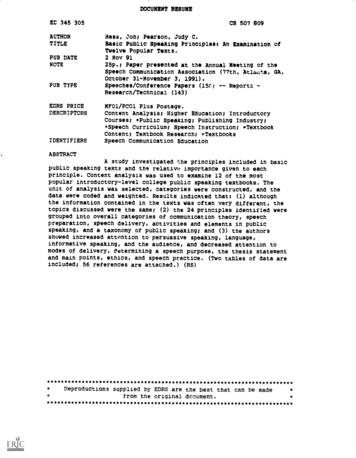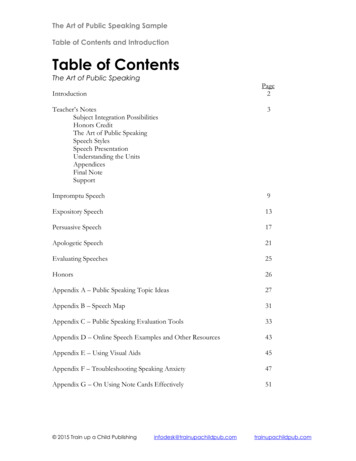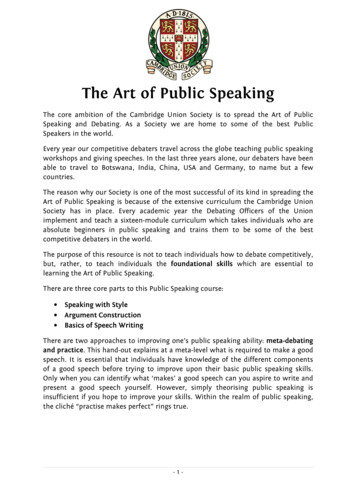
Transcription
The Art of Public SpeakingThe core ambition of the Cambridge Union Society is to spread the Art of PublicSpeaking and Debating. As a Society we are home to some of the best PublicSpeakers in the world.Every year our competitive debaters travel across the globe teaching public speakingworkshops and giving speeches. In the last three years alone, our debaters have beenable to travel to Botswana, India, China, USA and Germany, to name but a fewcountries.The reason why our Society is one of the most successful of its kind in spreading theArt of Public Speaking is because of the extensive curriculum the Cambridge UnionSociety has in place. Every academic year the Debating Officers of the Unionimplement and teach a sixteen-module curriculum which takes individuals who areabsolute beginners in public speaking and trains them to be some of the bestcompetitive debaters in the world.The purpose of this resource is not to teach individuals how to debate competitively,but, rather, to teach individuals the foundational skills which are essential tolearning the Art of Public Speaking.There are three core parts to this Public Speaking course: Speaking with StyleArgument ConstructionBasics of Speech WritingThere are two approaches to improving one’s public speaking ability: meta-debatingand practice. This hand-out explains at a meta-level what is required to make a goodspeech. It is essential that individuals have knowledge of the different componentsof a good speech before trying to improve upon their basic public speaking skills.Only when you can identify what ‘makes’ a good speech can you aspire to write andpresent a good speech yourself. However, simply theorising public speaking isinsufficient if you hope to improve your skills. Within the realm of public speaking,the cliché “practise makes perfect” rings true.-1-
Speaking with StyleIntroductionStyle is a crucial factor in the overall persuasiveness, clarity and cogency of one’sspeech. The most effective leaders in any organisation are individuals who arebrilliant communicators; one only needs to look at the public speaking skills ofvirtually every Head of State in the world to see this to be the case.From the outset it should be noted that speaking styles can vary drastically betweendifferent individuals. Irrespective, speakers with vastly different speaking styles canbe equally persuasive and, in turn, equally stylistic. No two speakers will have anidentical speaking style. It is also important to note that, when considering whatcounts as good style, you must at all times be asking yourself the question ‘who ismy audience?’The aim of this guide is not to teach a single good speaking style. Rather, it is tohighlight the various elements which help form the unique speaking style everyonenaturally has. Once you have come to learn the various elements of speaking styleyou should be able to identify possible weaknesses in your own style and target thespecific areas you wish to improve upon. These elements, taken as a collective, formthe Style Skeleton which individuals should be aware of when addressing anaudience.The Style Skeleton VolumeSpeedEngagementPerformanceVariationThe following section will deal with each of the elements of the Style Skeleton inturn.-2-
VolumeThere are three important points to consider about the volume at which you speak: Your first priority is to ensure you can be heard. Variations in volume, loudor quiet, can have certain rhetorical effect. That said, the most importantfunction of volume is trivially simple: you must ensure your audience can hearwhat you are saying. You must be aware of the effect of your volume upon your tone. Volumeconveys to your audience what the tone of your speech is. As a consequence,if you do decide to vary your volume, you should also note that you arevarying your tone. Variations in volume are key tools of emphasis. The most important stylisticdevice to emphasise a particular point is to vary the volume of your speech.Raising your voice at a crucial point, for instance the conclusion, drawsspecific attention to the importance of what you are saying and makes itmore persuasive. The converse, however, is also true; if you speak at aconsistently loud volume, you are unlikely to be able to rely upon thistechnique.SpeedThere are two important points to consider about the speed at which you speak: Ensure that you speak at a reasonable pace. It is a basic fact of humanbiology that we believe we speak slower than we, in fact, do. As aconsequence, individuals usually speak incredibly fast (especially when theyare nervous) rather than at a reasonable pace which is easy to follow. At theUnion, we often record our own speeches and listen to them to overcomethis simple defect in style. Speed is vital to keep your audience engaged. The speed at which you speakmust fit the subject matter which you are discussing. Altering your speed atthe right time will highlight important elements of your speech. For example,after giving a vital statistic you can briefly pause in order to allow theaudience to digest its significance.EngagementA speaker must ensure that they engage with their audience. You must make themfeel the speech you are delivering is tailored to them rather than simply organisedramblings of things you are interested in. There are various ways in which this canbe done:-3-
Make eye contact. By looking an individual in the eye and making eye contact,you are much more likely to get him or her to listen to what you are saying.Eye contact can be daunting but it is vital in order to hold a listener’sattention. If the audience is a sufficient distance away such that it would notbe obvious, it can help to focus upon the exact middle between the eyes ofaudience members, rotating between different individuals. Note taking. One of the easiest ways in which to ensure you engage is towrite your speech in note form rather than as an exact transcript of the wordsyou intend to say. As a consequence, you will not rely on the paper in front ofyou for your content but naturally become more conversational, and thusmore engaging. Do not go into ‘automatic mode’. Often, individuals who are giving apresentation simply remain in ‘automatic mode’ and aim simply to getthrough their presentation without engaging either with their own materialor with their intended audience. You should ensure you avoid doing this byrecognising the audience’s presence. Simply pausing for a question can beenough to ensure your audience is kept on their toes.PerformanceAny speech in in any context involves an element of performance. At the end of theday it is very unlikely that the way in which an individual presents him or herselfduring a speech will be the way in which that individual actually acts in his/hereveryday life. As a consequence, you must recognise that there is an element ofperformance in public speaking. Here is a short, non-exhaustive list of some dos anddon’ts: Do not sway whilst speaking.Keep your feet planted firmly into the ground whilst speaking. One slightlyeccentric yet oddly effective strategy adopted by some of our members is tostick a small piece of Blu-tac between the sole of your shoe and the floor as akinaesthetic cue to stop moving.Although gestures used in moderation can be helpful in emphasising specificimportant moments, excessive gesticulating is off-putting and will detractfrom your overall point.Do not slouch.Do not look at one specific point throughout the entire duration of yourspeech.Do not use filler words such as “umm” or “ahhh”. These are vocal tics usefulin conversation in order to make it clear that you have not finished speaking,but they have no place in public speaking, serving only to make you appear-4-
unprepared and unconfident. Consider simply pausing instead, which makesyou appear more in control of your material and of your audience.Do not ‘up-speak’ (this is when you finish a statement as if it were aquestion).It is impossible to come up with an exhaustive list of things individuals can orcannot do to enhance the performance element of their presentation. A simpleexercise, as noted above, is to record your speech with a video or audio recorder, andappraise the performance as if it had been delivered by somebody else.VariationIn general, there are two types of variation of style you should be aware of: Variation between presentations. What is demanded in terms of “style” froma particular speaker will be heavily dependent on what the situation demands.At all times a speaker should be asking themselves not only who they aretrying to persuade, but also what sort of idea they are trying to persuade theiraudience of. A presentation to your colleagues and a presentation to yourclients may therefore require you to adopt entirely different styles. As aconsequence, you must ensure that you vary your style betweenpresentations accordingly. Variation within presentations. As has already been explored above, variationis vital within presentations in order to induce certain reactions amongst youraudience. For instance, in attempting to convey the importance of a givenevent, a speaker might wish to speak in an excited, enthusiastic manner, butwhen a speaker is describing an unhappy situation in war-torn Somalia, theymay choose a more sombre, reflective tone.ImplementationWhen planning your speech, it is essential not just to structure your arguments(what you are going to say), but to structure your style-skeleton (how you are goingto say it).One of the most effective ways in which you can control your use of the various stylecomponents identified above is to deploy a style map. These can act as pointers toyourself to remind you to change your styles at the appropriate moment. To developa style map for any given speech, simply write next to each point in your speechwhich elements of the style skeleton you will deploy when saying that particularpoint).Upon deciding to deploy a particular stylistic element, you must ensure that youstrike the correct balance. A speaking style that is constantly changing is as bad as-5-
one that stays the same indefinitely. The power of stylistic effects diminishes withexcessive use.The importance of understanding the various components of a stylistic speech is verysimple: if you can identify the elements of a speech that makes it worthwhile tolisten to you can ensure that your presentations deploy the relevant stylisticconventions to make your speech excellent to listen to.-6-
Fundamentals of ArgumentationIntroductionIn British Parliamentary Debating, arguments need to be able to persuade any personfrom any background or country in the world, no matter what their politicaloutlook, life experience or preconceptions. In order for this to be possible speakers,must ground their arguments on logic and full explanation.In the boardroom or in front of a corporate group this is no different. Whencommunicating a message or putting forward a proposal, a speaker should nevertake an analytical step or factual detail for granted unless one can safely assume thatany ordinary intelligent person would accept the statement as self-evidently true.Most statements will not be self-evidently true. As a consequence, whencommunicating in public settings, what individuals are doing is constructingarguments, whether they realise it or not. The aim of this section is to explain theFundamentals of Argumentation.It is important to remember what arguments are not before understanding whatarguments are: Arguments need not be aggressive, or aggressively delivered.Arguments need not be confrontational.Arguments are not simply a series of premises or unconnected statements.To put it simply, an argument is a clear, delineable chain of logic which would beintelligible to a reasonable and ordinary observer. There are three things allarguments require: Justified premisesEffective conclusionsSufficiently explicated logical links between the premises and conclusionsThe aim of this document is to provide a structure of argumentation whichindividuals can deploy in any setting.There are three complementary models of argumentation which we will examine indetail:-7-
“Now – Action – Then”“REAL” (Reason – Evidence – Analysis – Link)“I – A – E” (Idea – Analysis – Evidence)After examining the different models of argumentation, we will examine in detail thebest ways to deploy evidence, examples and observations in public speeches.Now – Action – ThenNow At this point one should illustrate their version of the "status quo" ordescribe the situation as it is now. The speaker should describe the statusquo in a way that is plausible, but also in such as way to provide a reasonto act or an imperative. E.g. 'We are currently wasting X per annum onan expensive internet service provider.'Action This stage is where a speaker should introduce their proposal. Theproposal should relate in someway to the reason or imperative identifiedabove. E.g. 'We propose to switch to Y, a cheaper internet serviceprovider.'Then This is the most crucial stage of your argumentation. A speaker mustidentify and explain the result of implementing their proposal. The mostimportant part of the "Then" stage is to identify the comparative. Inorder to do this, two things must be noted. First, how is the resultdifferent from the status quo? Second, in what meaningful way is theresult better? E.g. 'If we switch to Y, we will be charged less, and this willsave us money.'Pitfalls to avoidThe NAT model of argumentation is elegant and simple, but only the beginning of aserious argumentative process. Individuals who wish to deploy NAT must ensure they engage in premisejustification. The “Now” or “Status quo” or “reason” to act may often becomplex. Often, especially in a corporate setting, individuals must be ready tofully explain their evidence for what the given status quo is. NAT can often struggle to accommodate complex argumentation. In order toget around this problem, speakers must adopt more advanced substructureswithin their speech. To engage in this form of argumentation two things arerequired:o Multiple justifications for each stage (N-A-T)o Multiple steps between each state.-8-
NAT cannot accommodate non-consequentialist argumentation. Although itis unlikely that in a boardroom or corporate setting a speaker would wish tomake a principled or normative claim, it should nevertheless be noted thatnon-consequentialist argumentation must operate outside the model of NAT.REAL ArgumentsReasonExplanationEvidenceLinkThe REAL method of argumentation is often the best way to incorporate more inone’s claims, irrespective of the subject matter.Elements Reason. This is simply a headline to the particular line of analysis. In order forthis to be most persuasive, think of this as a politician’s tagline. A listenershould be able to listen to your reason and intuitively feel there is someimportant imperative to act. Explanation. To find an explanation for your reason, ask yourself the simplequestion ‘why is this a good reason?’ At this point, one can incorporate theNAT model of argumentation within the REAL model. Whilst deploying REAL,one can fall back to the simple NAT methodology at the explanation stage toprovide further ‘teeth’ to claims and arguments. Take, for instance, this verysimple argument based on legalising prostitution (N.B. Whilst legalisingprostitution will never be the subject of boardroom discussions or corporatepresentations, the example will show how relatively intuitive claims can beordered to make a comprehensive argument):o Reason: legal prostitution will be safer than illegal prostitution.-9-
o Explanation: Now: At this moment in time prostitution is illegal and isderegulated. As a consequence of this illegality it occursnaturally, without any controlling measures, from the state. Action: If something is legal it can be regulated. Removingcriminality from prostitution could result in state-regulatedbrothels in which there is compulsory contraception, legalprotection and other such safeguards. Then: If there is a legal prostitution sector, there will be noincentive for prostitutes to operate in the more dangerous blackmarket. As a consequence, the dangerous black market inprostitution will come to an end.o Evidence: An Australian study shows STIs were 80 times higher in theillegal sector of prostitution than in comparable legal sectors.o Link: If the government can make something safer for all then itshould. Evidence. Examples are extremely important. At this stage, individual speakersshould deploy relevant pieces of evidence in order to be as persuasive aspossible. For effective use of evidence, please see page 11. Link. The link should explain why the reason you put forward and thearguments you have given are relevant to the wider claim you are making.Links are often evaluative statements appealing to some intuition. In mostcorporate settings, your link will often be “we will make more money thisway” or “this way our business will stay afloat”. Irrespective, it is stylisticallyappealing and important from a listener’s point of view if a speaker does notleave it up to imagination, instead articulating the relevant link to theirargument.- 10 -
I-A-E ArgumentsIrrespective of the sophistication of the models presented above, good argumentsare inherently lucid. Each individual may in very different contexts deploy, eitherconsciously or unconsciously, their own varied form of argumentation. Perhaps, youas an individual speaker prefer to speak without the rigidity of the models presentedabove.The IAE model of argumentation is the most flexible form of argumentation. Itpresupposes the following:The Anatomy of an Argument contains the following threethings: an Idea, Analysis and Evidence.The central tenet of this ‘model’ of argumentation is that, so long as an individualpresents an idea substantiated with some form of analysis with the use of evidence,he or she will be presenting a cogent argument. Idea. The Idea refers to the concept or proposition that an individual has setout to prove. It might be a simple assertion that a given idea is good, or thatan evaluative statement is on the balance of probabilities correct. Analysis. Analysis is the mechanism whereby you can explain why yourcentral proposition is correct or logical or reasonable to the ordinary andintelligible listener. There are various things one ought to bear in mind:o In the vast majority of contexts it will be relevant to ask yourself thefollowing: “Why does my proposition/idea/contention/proposal lead toX bad/good outcome”; “why is X good/bad?” and “why is X important inthe context of competing considerations?”o When presenting a premise, you must challenge the premise by askingyourself “why?” Please note, that too often, speakers at the analysisstage of their argument in answering the question “why?” resort to“evidence” rather than a cogent and reasoned response. Of course,there are many scenarios where one’s analysis is best illustrated byevidence rather than logic, but, a speaker should ensure there is asmuch logic in one’s analysis as possible before resorting to evidence,for argument in which an audience may actively participateconsistently proves more persuasive.o Irrespective of what is stated above, at some point a speaker must stopasking “why”. Note Agrippa’s Trilemma, a philosophical term stressing- 11 -
the purported impossibility to prove an absolute truth. The aimtherefore when speaking is to exhaust a reasonable level of analysisbefore relying on purely epistemic criteria to prove one’s point (i.ethrough observation and examples).The importance of the I-A-E model of argumentation is not to provide a structure perse for one’s speech, but rather to identify the three elements of the anatomy of anargument. If one uses these three elements in a clear fashion, he/she will bepresenting a clear and cogent speech.Evidence – Examples – ObservationsFrom the outset, the use and relevance of examples when presenting an argument isperhaps the most controversial part of speechwriting and argument construction.For instance, in the NAT model of argumentation there is no mention of evidencewhatsoever. Many individuals can construct arguments without recourse toevidence, examples or observations.Examples are not free standing entities which embody an argument itself, but,rather, they are an extremely useful tool which should be used to validate one’sreasoning.The relationship between arguments and examples can be explained as follows:whilst arguments embody reason, logic and theory to explain a given state of affairs,evidence, examples and observations explain and elucidate instances of how yourmodel of reasoning which you present has actually come to pass. Examples ought to validate your reasoning. For this reason it is natural thatthey should often follow your analysis rather than precede it. This is not anabsolute rule and there may be occasions where it is more appropriate tostart with an example. Examples, evidence and observations must be relevant. Relevant examplesmay be either directly relevant or indirectly relevant.o For directly relevant examples, a speaker should not have to explain theconnection between the relevance of the example and the analysiswhich surrounds it.o For indirectly relevant examples, a speaker should spend timeexplaining the connection between the relevance of the example andthe analysis which surrounds it. Often this is done by drawing ananalogy and explanation of context.- 12 -
Do not overburden your speech with examples. For instance, a presentationwhich contains lists of statistics will never be persuasive and often cause thelistener to be disengaged. Prioritise your use of examples. There may be many different examples whichsupport your reasoning and point of view. In choosing the ‘best’ examplesconsider the following:o Examples from recent history are generally more relevant thanexamples from the pasto Hypothetical examples are generally the least relevant and leastpersuasive exampleso Similarly useless are personal anecdoteso Case studies which aim to prove a hypothesis are most useful when therelevant study recognises that it is not absolutely true; quantified doubtis often much more reassuring than case studies which claim absoluteproof Know the source of all examples used. A speaker must be ready tosubstantiate the credibility of any examples.- 13 -
Basics of Speech WritingOnce one has come to terms with the two most important facets of public speaking(Style and Argument Construction), the next thing you need to learn is how to writea speech or presentation.Every individual will have their own unique approach to this task. Like style, there isno one standard form or structure which can be deployed in every context.That being said there should be three elements of speech writing everyone shouldconsider: Note TakingTaglinesSynchronisation with Visual AidsNote TakingAs mentioned above, speeches should not be written out in full or to the letter. Thebest presentations are ones where individuals use cue-cards or write in bullet-pointform on an A4 sheet.One of the questions an individual new to public speaking often asks is “what shouldI write in my notes?” It is difficult to give a general answer to this question. Perhapsthe best way to answer this question is to consider the function of note taking: notesshould be statements which can point you in the right direction for the nextsegment of your speech.Another test an individual can use to test whether or not their notes are sufficientlyrobust is whether or not upon looking at your notes, an individual who had notwritten the speech would be able to “fill in the gaps” in logic between one statementand the next. Do not leave too much to memory.TaglinesIt is extremely important to flag the important points in your presentation. Oftenpresentations are split into various sections (different proposals or points). In orderto make these proposals more memorable, take some time to think of a taglinewhich describes the point you wish to make.- 14 -
The best way to conceive of a tagline is to think of sound-bites politicians often useto describe their policies. It can be a short one sentence which summarises the pointof your discussion.Using taglines in this fashion keeps your speeches structured. The best way to deploytaglines is in the following simple manner: Use a tagline to introduce a point and inform your audience that this will bethe next subject matter of discussionDiscuss the subject matterUse the tagline in the conclusion of your discussion of the subject matter toreinforce what you have just discussedThe above is another formulation of the classical illustration of the structure of aspeech: “Say what you are going to say, say it, and then tell your audience what youhave said”.Taglines are also perfect for introducing and summarising your speech so that youraudience feel that your speech is structured, and therefore more persuasive.Whilst a tagline may prove a rhetorically-attractive label for your argument,remember to ensure that the actual content of your speech fits into one of themodels of argumentation outlined in the section above (NAT, REAL or IAE).Synchronisation with Visual AidsIn more recent years, perhaps the most important part of speech writing is to yourpresentation corresponds with any visual aids you are using, most often a MicrosoftPowerPoint Presentation.There are various points to note: Track your speech. Ensure that when practising your presentation you do sowhilst tracking the changes in the slides. If you are using a slide-show it looksunprofessional if the subject matter of your discussion does not correspond tothe slide your audience will be looking at. Do not let visual aids overpower you. If you are standing in front of a largescreen, it can often detract from you and from whatever you have to say. Takethis into consideration when thinking about the particular style you wish toadopt in your presentation. For instance, if your presentation is particularlyvisual, you may have to adopt a very commanding tone and volume in orderto ensure attention remains on you and the substance of your presentation atall times.- 15 -
Do not read out from the PowerPoint presentation. If the content of thePowerPoint presentation is identical to the content of your speech, you simplyundermine the intelligence of your audience if you read out from a largescreen what the members of your audience will most probably be able to readthemselves. For this reason, ensure the content of your presentation andspeech are complementary (discussed below). Have complementary content in your visual aids and speech. To avoidreading from the presentation, ensure that the content of the visual aids andspeech are complementary in content. The best balance is often to have asummary of the different segments of your proposal on the screen whilst theactual content of your speech explains in much greater detail the specificpoints you wish to make. In addition, it is helpful if you use the PowerPointfor elements of your speech your audience are unlikely to remember such asstatistics, but devoid of the argument you have constructed and for whichthey are a vehicle. This will allow the audience to listen to your argument,safe in the knowledge that the facts and figures will be waiting for them onthe handout.- 16 -
The Art of Public SpeakingThis guide to the Art of Public Speaking is supposed to provide individuals withsufficient knowledge such that they can improve upon their public speaking skills.Public speaking is an extremely complex craft that has various elements to it. Uponfamiliarising yourself with these elements throughout the guide, it should be notedthat there is a wide discretion afforded to individuals to find the type of PublicSpeaking that suits them.Everything from argumentation construction to speaking with style to writing yourspeech down on paper must be done in the way in which you are most comfortable.At the meta-level, public speaking and persuasion have discrete core componentswhich are readily-identifiable. However, when put into practice, all your listenerswill hear is a single speech. The best way to improve, to put it simply, is get betterspeech by speech.- 17 -
Art of Public Speaking is because of the extensive curriculum the Cambridge Union Society has in place. Every academic year the Debating Officers of the Union implement and teach a sixteen-module curriculum which takes individuals who are absolute beginners in public speaking and trains them

